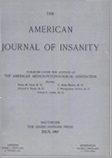A DEFECTIVE MENTAL MAKE-UP AND THE PERNICIOUS FORMS OF TORTICOLLIS, TINNITUS, NEURALGIA AND PRURITUS
Abstract
The object of this communication is to indicate that the pernicious forms of tinnitus aurium and pruritus of the ano-genital region, spasmodic torticollis and trigeminal neuralgia may be similar in nature and to give the reason for this similarity
It is pointed out that with certain apparent exceptions they are alike as to age of onset, course, resistance to treatment, predominance of one symptom in clinical picture, and central nervous origin.
Tinnitus aurium is found not to be an exception if one accepts Gray's contention that the changes in otosclerosis must affect all parts of the biological and physiological unit subserving the function of hearing.
Trifacial neuralgia is also not necessarily an exception for the evidence commonly supposed to indicate a peripheral lesion is from another point of view equally in favor of a central disorder.
The psychic deviations frequently associated with tinnitus do not seem to conform to classical types of mental disorder. Psychic deviations also are said to occur in the other forms but their nature cannot be ascertained.
The nature of the patient's mental reaction to symptoms in these forms is indicative of something more than a peripheral disturbance.
Gray's conception of a degenerative defect limited to a biological and physiological unit offers the best explanation of the pathogenesis of these forms of neurosis and gives the reason for their similarity as to age of onset and course, stability of clinical picture, resistance to therapy, predominance of one symptom, central nervous origin, and the association of uncommon psychic deviations. This conception should prove of further service in the study of neuroses and psychoses.
Access content
To read the fulltext, please use one of the options below to sign in or purchase access.- Personal login
- Institutional Login
- Sign in via OpenAthens
- Register for access
-
Please login/register if you wish to pair your device and check access availability.
Not a subscriber?
PsychiatryOnline subscription options offer access to the DSM-5 library, books, journals, CME, and patient resources. This all-in-one virtual library provides psychiatrists and mental health professionals with key resources for diagnosis, treatment, research, and professional development.
Need more help? PsychiatryOnline Customer Service may be reached by emailing [email protected] or by calling 800-368-5777 (in the U.S.) or 703-907-7322 (outside the U.S.).



